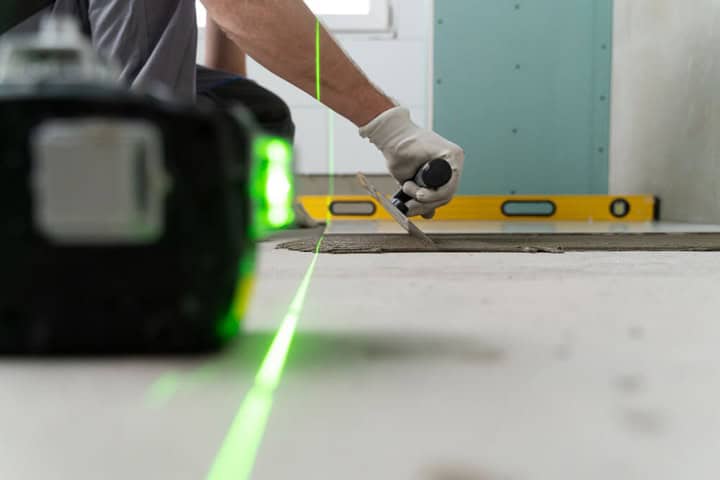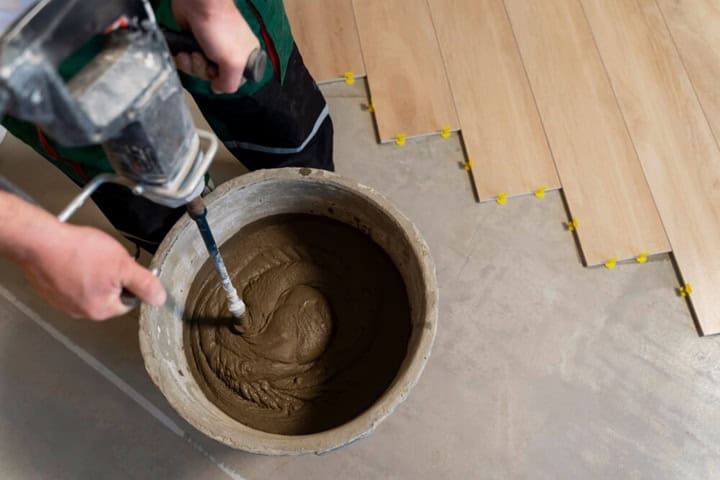Is underfloor heating suitable for concrete floors? Discover how concrete flooring does not limit the type of heating that you have in your home, especially with underfloor heating added to the mix…
There are many flooring types that you will come across in UK buildings; one of the most popular is concrete flooring, even as the first or final layer of flooring. But did you know that you can still transform your cold, hard concrete floors into a source of warmth and comfort? In this article, you will learn how to install underfloor heating on concrete floors, whereupon you will discover how the efficient, space-saving features of underfloor heating can bring greater benefits to your concrete flooring.
Key Points:
- Selecting the best underfloor heating system for concrete floors.
- Step-by-step installation process from insulation to finishing.
- Key considerations for maintaining structural integrity and preventing heat loss.
- Overview of costs and professional installation options.
- Tips on maximising the efficiency and longevity of your heating system.
- How to Install Underfloor Heating on Concrete Floors
- 1. Preparing the flooring
- 2. Adding the Perimeter Strip
- 3. Preparing the Installation Area
- 4. How to Lay Underfloor Heating Insulation Boards
- 5. Installing the Heating System with Pipes
- 6. Applying the Screed
- 7. Choosing and Applying The Right Floor Finish:
- Should You Install Underfloor Heating on Concrete Floors DIY Or With A Professional?
- Key Considerations
- Manage Moisture and Cracking
- Retrofitting
- Heating Systems for Concrete Floors
- How Much Does Underfloor Heating on Concrete Floors Cost?
- Potential Risks to Concrete Floors
- Effective Heat To Be Made From Concrete Flooring
- FAQs
- Sources
How to Install Underfloor Heating on Concrete Floors

Whether you’re updating existing concrete floors or integrating underfloor heating into a new construction, here is the best approach on how to install underfloor heating on concrete floors:
1. Preparing the flooring
To prepare underfloor heating for concrete floors, simply expose the layer of concrete flooring that you wish to lay down the underfloor heating on.
Once you have done this, clear the flooring of any debris, dirt, or dust to make the area as clean as possible. Most floorboards can be added to concrete flooring once they are dry, flat, and leveled out.
Other details you need to check over when preparing your flooring are signs of damp, grease, or oil that could cause problems later down the line if you do not adjust these first. Problems like damp and grease can prevent the adhesive from working properly and delay the process.
2. Adding the Perimeter Strip
When installing underfloor heating on concrete floors, ensure that you remove any skirting boards and doors from the area to give you maximum access to the flooring. You will also need to trim them when preparing your final floor finish. Lay down a perimeter strip around the edges of the designated area, and can use sticky tape or a staple gun to keep the adhesive secure. The perimeter strip will allow you to monitor the entire area where you are going to be laying down the underfloor heating as well to help with expansion and reduce heat loss.
To help aid this process of installing underfloor heating on concrete floors, you can add polystyrene boards to help with insulation and monitor how thick they will be when measuring the room’s height if they are too thick.
3. Preparing the Installation Area
Before laying down any components, insulate the area thoroughly. Insulation boards are essential for preventing heat from escaping quickly, especially when working with underfloor heating on concrete floors, which are naturally heat conductive.
Opt for insulation materials like rigid foam, foam spray, or aluminum foil-backed insulation to cover walls, floors, and lofts.
Proper insulation ensures that the heat remains where it’s needed and improves the system’s overall efficiency. Want to learn more? Discover how to use underfloor heating efficiently.
4. How to Lay Underfloor Heating Insulation Boards
Polystyrene boards are commonly used for their excellent insulation properties and simple installation.
When installing these boards, consider their thickness to avoid reducing room height significantly. Ensure that the boards are securely fitted and cover the entire floor area to create a uniform layer that will support the heating system.
5. Installing the Heating System with Pipes
For better heat distribution, install the heating pipes or cables directly on top of the insulation boards. It’s important to position these elements closely to avoid cold spots, ensuring a consistent and balanced warmth across the floor.
For water underfloor heating systems on existing concrete floors, ensure that the pipes are well-aligned and securely attached to avoid any shifts during the screed application.
6. Applying the Screed
The next step involves covering the pipes with a layer of screed, which typically consists of a sand-cement mixture. This layer not only protects the heating elements from physical damage but also aids in heat distribution.
Semi-dry screed is frequently preferred due to its ideal balance for thermal conductivity and load-bearing capacity. Composed typically of a cement and sand mixture in a 3:1 or 4:1 ratio, this screed type achieves a smooth finish once water is added.
For a greater performance, concrete with a hardness rating of C35 (35 newtons) and a water to cement ratio below 0.40 is recommended. This specification ensures the concrete is sufficiently robust to handle the thermal demands of underfloor heating systems without compromising structural integrity.
Apply the screed evenly, maintaining a thickness of about 50mm-75mm to optimise thermal conductivity and ensure a level surface for the final flooring.
Here are more helpful tips about screed:
7. Choosing and Applying The Right Floor Finish
Underfloor heating systems are compatible with various types of floor finishes, from tiles and hardwood to carpet.
Select a finish that complements your interior design while being conducive to heat transfer. It’s important to choose materials that conduct and withstand heat well, ensuring the efficiency of your heating system.
Try these articles for common flooring types:
- Does underfloor heating work with carpet
- Laminate flooring for underfloor heating
- Vinyl flooring with underfloor heating
What are the pros and cons of concrete flooring? Find out now.
Should You Install Underfloor Heating on Concrete Floors DIY Or With A Professional?
While DIY installations are worth considering for those with experience, it is still better (and safer) to hire a professional heating engineer or consulting with a concrete specialist.
Professionals can provide insights into the best practices for underfloor heating installations, help prevent common mistakes like uneven heating, and ensure that your installation adheres to building regulations.
Want to get in touch? Find out how to contact us today so that we can assist with your underfloor heating on concrete floor installation.
Key Considerations
Whilst these easy to follow instructions paint a bigger picture of what is needed before and during your installation process, there are still some factors to consider to ensure the best results:
Manage Moisture and Cracking
Concrete is prone to cracking if not properly managed. This is why it is important to consider the following measurements:
- Ensure the room is well-ventilated.
- Consider moisture control techniques during the curing process, (regular misting).
- Use perimeter joints around the installation area to accommodate expansion and contraction, safeguarding against structural compromises.
Retrofitting
For complex setups, such as retrofitting underfloor heating on existing concrete floors or integrating advanced control systems, hiring experienced professionals can avoid costly errors and ensure a seamless operation.
Heating Systems for Concrete Floors
These are the underfloor heating systems that you can combine with concrete flooring:
- Electric Underfloor Heating Systems: Electric systems, featuring thin heating wires installed just beneath the surface of the floor, are well-suited for renovations with minimal disruptions. These systems heat up and cool down gradually, making them ideal for continuously used spaces. They are relatively simple to install and can be laid directly onto the insulation layer, making them a popular choice for underfloor heating on existing concrete floors.
- Water Underfloor Heating Systems: Alternatively, wet or hydronic systems are perfect for new installations, especially with freshly polished concrete floors. These involve a network of pipes connected to a boiler, circulating heated water throughout the floor for an even distribution of heat. Such systems are generally more efficient for larger areas due to their ability to maintain consistent temperatures across expansive surfaces.
How Much Does Underfloor Heating on Concrete Floors Cost?

The cost of installing underfloor heating varies widely, typically ranging from £500 to £8,000, based on the choice you make with your underfloor heating system, the total area to be heated, and the complexity of the installation. Electric systems tend to be more cost-effective and easier to install, making them a good option for those on a tighter budget or dealing with smaller spaces.
It’s crucial to evaluate the full scope of the project, including any additional renovations needed, to ensure that the heating system fits within your financial plans without compromising on quality or functionality.
Underfloor Heating on Concrete: Main Benefits
There are a range of benefits towards adding underfloor heating on concrete floors, including the following:
- Improved Heating Efficiency: One of the main benefits of underfloor heating is its ability to distribute warmth evenly across the entire floor surface. Unlike radiators that create hot spots and cooler areas, underfloor systems give you a consistent, cosy warmth underfoot. Concrete retains heat exceptionally well, so once warmed up, the floor continues to radiate heat for longer — making it an ideal match for an energy-efficient home.
- Cleaner, Healthier Air: Traditional radiators can cause dust to circulate as warm air rises, carrying particles upward before they spread around the room. By contrast, underfloor heating uses radiant floor heating, which minimises air movement and reduces the amount of dust in circulation. This can make a noticeable difference for households with allergy or asthma concerns and those with central heating allergy symptoms.
- Maximised Living Space: Bulky radiators can limit how you arrange your furniture or decorate your rooms. By moving the heat source beneath the floor, you free up valuable wall space and create a more flexible layout. This not only makes smaller rooms feel less cluttered but also gives you greater freedom in designing your interiors.
Potential Risks to Concrete Floors
While underfloor heating systems offer significant benefits, improper installation can lead to issues with the concrete substrate.
The main concerns include cracking, shrinking, or expanding if the concrete’s temperature and moisture are not carefully managed.
Ensuring that the installation complies with all necessary standards and regulations is crucial to mitigate these risks.
Effective Heat To Be Made From Concrete Flooring
By this point, your underfloor heating on concrete floors should be ready to go. Turn on the equipment, and within a matter of minutes, you should begin to notice a difference already from your underfloor heating, after following the instructions laid out before you.
If you have used the right adhesive and followed the pipe layout accordingly, your energy bills should also begin to drop over time too.
By following these steps, you can install reliable and efficient underfloor heating on concrete floors that will provide warmth and comfort during the cold winter months. With underfloor heating, you can enjoy a warm and cozy home without the need for bulky radiators or noisy fans.
FAQs
Can you put underfloor heating straight onto concrete?
Yes, you can install underfloor heating directly onto a concrete floor.
How do you prepare a concrete floor for underfloor heating?
To prepare a concrete floor for underfloor heating, ensure the surface is clean, dry, and level, apply insulation boards if necessary, and install a suitable thermal barrier or screed layer over the heating elements.
Do you have to dig up concrete floors for underfloor heating?
No, you do not have to dig up concrete floors to install underfloor heating; systems can be installed on top of existing concrete, embedded within a new screed layer, or placed beneath floor finishes.
Can underfloor heating be installed on existing concrete floors?
You can install underfloor heating on an already existing concrete flooring. Electric underfloor heating is better for this process, and so long as the flooring is polished, you should be able to fit in an insulation system, too, without too much of a problem.
Can underfloor heating be added on top of the screed?
Most screeds are usually found to be added as floating screed for most varieties of underfloor heating or insulation methods. This can be done by placing the screed on a separate membrane which will be added on top of the underfloor heating.
When installing underfloor heating on concrete floors, how much concrete should be added over underfloor heating?
Applying concrete at a thickness rate of 50-75mm will make a big difference for allowing the concrete to handle heating parameters better.
Sources
Lewitin, J., (2024). Concrete Flooring Review: Pros and Cons. The Spruce. [online] Available at: https://www.thespruce.com/in-depth-look-at-concrete-flooring-1314684 [accessed 13/01/2025]
